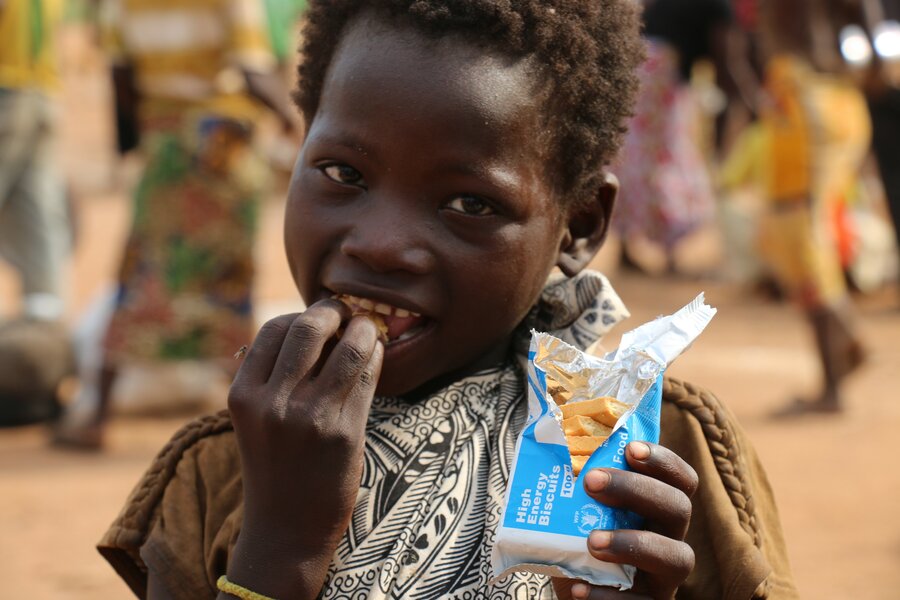
About WFP
WFP works to save and change the lives of more than 115.5 million people in over 120 countries and territories. WFP is among the first on the scene in an emergency, providing food and other assistance to the victims of conflict, drought, floods, earthquakes, hurricanes and crop failures, as well as pandemics such as the current global outbreak of COVID-19. At the same time, we keep a sharp focus on sustainable development, providing governments with the support and skills to manage food security in the long term.
Nobel Peace Prize
The award of the Nobel Peace Prize to WFP in October 2020 reflects our strong advocacy for the critical role of peace in ending hunger, and for the use of food as a tool for peace.
Conflict and insecurity are key drivers of hunger. Many of the people WFP supports are fleeing conflict, and have been forced to abandon their land, homes and jobs. This award increases WFP's opportunity to provide a stronger voice to more than 800 million hungry people in the world and to mobilize support for the food assistance that they need.
Quick facts
- WFP is funded entirely by voluntary donations, with a record US$9.6 billion raised in 2021 - still US$5.2 billion short of requirements.
- More than 50% of the people WFP serves are women and girls.
- WFP has more than 21,800 staff, of whom more than 87 percent are field based.
A global hunger crisis
Up to 828 million people - more one in ten of the world's population - still go to bed hungry each night. Acute food insecurity has reached unprecedented highs, affecting a record 345 million people - up from 135 million in 2019. A total of 50 million people in 45 countries are teetering on the edge of famine.
A deadly combination of conflict, climate change and the after-effects of the COVID-19 pandemic is at the root of soaring hunger numbers. The economic fallout of the pandemic, and then the war in Ukraine, has pushed prices up and putting food out of reach for millions of people across the world.
These rising costs are also affecting WFP's work. Already at the start of 2022, the price WFP was paying for food was up by 30 percent compared to 2019, and the cost of delivering it had risen by an additional US$42 million a month. After the outbreak of conflict in Ukraine, WFP is forced to pay US$73.6 million more a month for operations than in 2019 - a staggering 44 percent rise.
While Asia is home to the greatest number of undernourished people at 418 million, Africa is the region with the highest prevalence of undernourishment in percentage terms, at 21 percent. This is more than double the rate in all regions, according to the latest edition of the State of Food Security and Nutrition in the World.
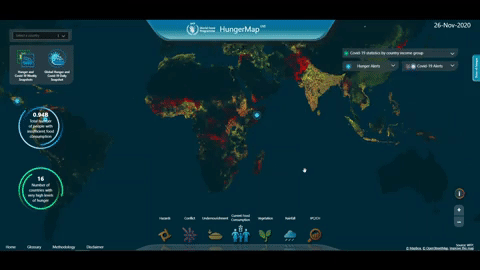
Threat of famine
There are 50 million people in 45 countries at the "emergency" phase of food insecurity in 2022, just one step away from a declaration of famine. People in Afghanistan, Ethiopia, Somalia, South Sudan and Yemen are at particular risk.
WFP urgently needs funding to avert famine, chiefly through life-saving food and nutrition assistance. The price of doing nothing in the face of growing hunger will inevitably be measured in terms of lost lives. In September 2022, the UN revealed "concrete indications" that famine is at the door for people living in Somalia's southern Bay region, unless adequate funding and safe access for humanitarian workers are secured. See also: Fighting famine
Main areas of work
Emergency response* and preparedness
WFP is the frontline agency responding to emergencies caused by conflict, climate shocks, pandemics and other disasters. We also coordinate responses to large-scale emergencies on behalf of the wider humanitarian community, as lead agency of the Logistics Cluster and the Emergency Telecommunications Cluster. Our focus is also on emergency preparedness, working with partners to provide early warning and helping communities lessen the impact of looming disasters.
- Each day WFP has up to 5,600 trucks, 30 ships and 100 planes on the move, delivering food and other assistance.
(*See also 'Current emergencies' section below)
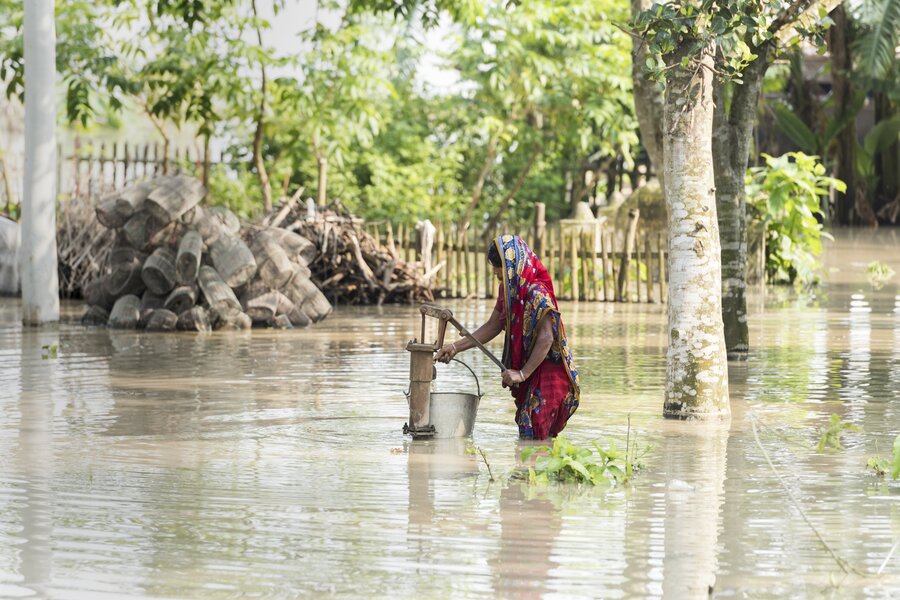
Climate change
Climate shocks such as droughts and floods can wipe out crops, disrupt markets and destroy roads and bridges. WFP is working with governments and humanitarian partners on the frontlines, responding to an increasing number of disasters. At the same time, we take pre-emptive action which reduces the number of people needing humanitarian assistance.
WFP deploys Forecast-based Financing to provide cash to vulnerable families, allowing them to buy food, reinforce their homes and take other steps to build resilience ahead of climate disasters. This approach was used ahead of torrential rains in Bangladesh in July 2019.
- 12.2 million people across 47 countries benefited from climate risk management solutions in 2021, including 2.7 million in 14 countries who were protected by climate insurance.
Nutrition
Sustainable development is only possible in communities where malnutrition is eradicated and future generations can flourish. WFP has broadened its focus in recent years from emergency interventions to addressing all forms of malnutrition including vitamin and mineral deficiencies, and overweight and obesity.
WFP addresses malnutrition from the earliest stages through programmes targeting the first 1,000 days from conception to a child's second birthday. We provide access to healthy diets, targeting young children, pregnant and breastfeeding women and people living with HIV.
- 23.5 million people - primarily children and pregnant and lactating women and girls - benefited from WFP programmes for the treatment or prevention of malnutrition in 2021. That's a 36 percent increase on 2020.
School feeding
WFP is the largest humanitarian organization implementing school feeding. School meals improve children's nutrition and health, while also increasing access to a potentially life-changing education. Home-grown school feeding sources food from millions of smallholder farmers, increasing their incomes and boosting local economies.
WFP and UNICEF are joining forces under a renewed commitment to millions of vulnerable children. The initiative will focus on supporting governments in adopting an integrated approach to schoolchildren's nutrition and health, incorporating school feeding, nutrition, deworming, and water, sanitation and hygiene.
- WFP provided 15.5 million children with nourishing meals, school snacks or take-home rations in 2021, despite large disruptions to schooling caused by the COVID-19 pandemic.
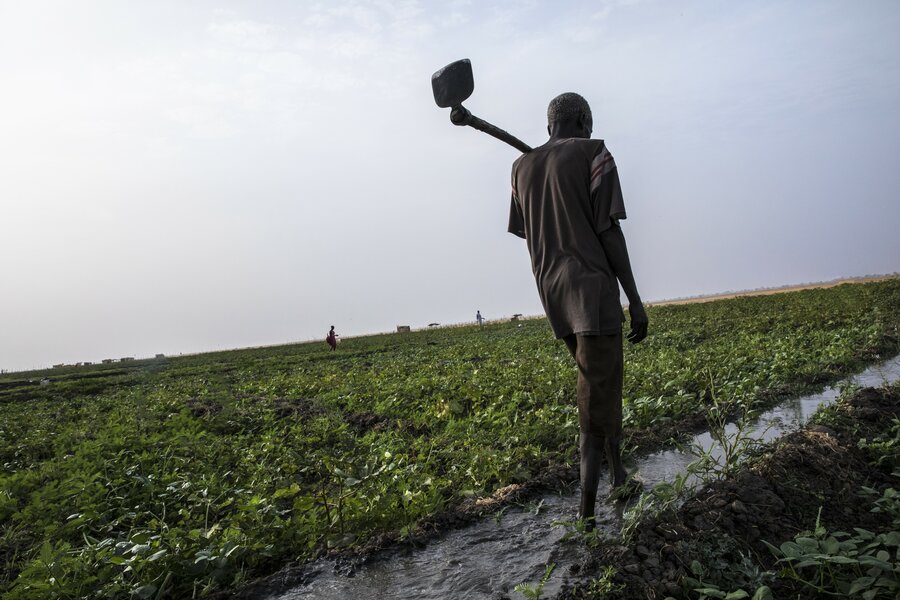
Smallholder farmers
Smallholder farmers produce most of the world's food and are critical in achieving a zero-hunger world. WFP's support to farmers spans a range of activities to help build sustainable food systems, from business-skills training to opening up roads to markets.
- WFP and partners supported more than 947,000 smallholder farmers in 44 countries in 2021.
- WFP procured 117,000 metric tons of food valued at US$51.9 million from smallholder farmers in 27 countries in 2021.
Asset creation
WFP's Food Assistance for Assets programme improves the prospects for long-term food security, while helping create conditions for peace. People receive food or cash to meet immediate food needs, which frees up their time for working on community assets or livelihood resources that can increase resilience to climate change and improve access to markets.
- WFP provided food assistance for 8.7 million people through food assistance for assets activities in 2021.
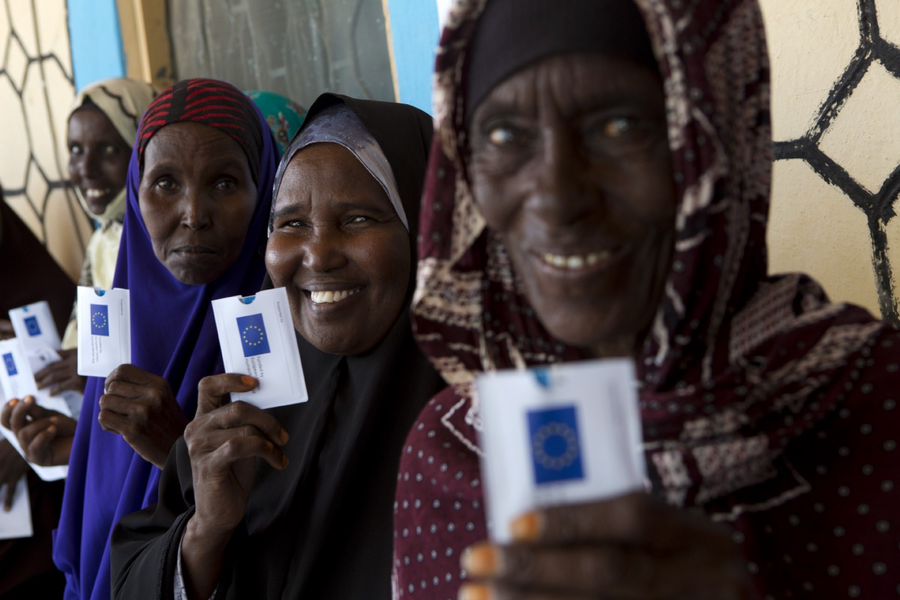
Cash assistance
WFP is the largest cash provider in the humanitarian community. Cash allows for increased food choices and diet diversity for beneficiaries while boosting local smallholder production, retail and the financial sector.
- US$2.3 billion was provided to 41.8 million people through cash or vouchers in 2021.
Capacity building
Through its Country Strategic Plans, WFP is transferring its skills and knowledge to a range of public, private and civil society actors who are pivotal to sustaining national policies and programmes. We are building governments' and other partners' capacities to manage disaster risk and improve food security, while also investing in early warning and preparedness systems for climate and other threats.
- WFP is training government staff in Ethiopia in the use of drones for activities such as mapping flood-risk zones and assessing damage to crops after disasters - building their abilities to deploy the technology without WFP's assistance.
- In Bangladesh, we provided training to staff from the NGO Social Assistance and Rehabilitation for the Physically Vulnerable, so they could implement a community-based nutrition project.
Digital innovation
WFP's digital transformation is about embracing new technologies and data that will help realize the goal of zero hunger by 2030. WFP's Munich-based Innovation Accelerator was launched in 2015 to pilot new solutions and scale promising innovations to disrupt hunger. In just five years, we've supported more than 80 projects around the world, with 14 innovations scaling up to reach 3.7 million people.
- In Jordan, we deploy blockchain technology that allows more than 100,000 Syrian refugees to buy groceries from local shops using iris scans instead of cash, paper vouchers or credit cards.
- H2Grow allows people threatened by hunger to grow their own food in harsh conditions, using saline solutions instead of soil, in seven countries. In the Algerian desert, more than 200 hydroponic units are producing animal fodder which boosts the milk and meat yield of goats. This is turn improves food security for some of the thousands of Sahrawi refugees.
Current emergencies
Ukraine
WFP has launched an emergency operation to provide food assistance for people fleeing the conflict inside Ukraine and in neighbouring countries. There are plans to assist up to 4.8 million people inside the country each month, chiefly through cash and food. WFP teams have set up operations and hubs in a number of locations in neighbouring countries, both to facilitate delivery of food assistance into Ukraine and to assist refugees coming over the borders. WFP is also leading the emergency telecommunications and logistics clusters on behalf of the UN.
See also: Emergency page
Afghanistan
Afghanistan is becoming the world's largest humanitarian crisis, with 18.9 million people - nearly half the population - now facing acute food insecurity, including 6 million facing emergency levels of food insecurity. An already desperate situation has been compounded by drought, escalating displacement, the collapse of public services and deepening economic crisis. An earthquake in late June will only add to the already massive needs. WFP aims to reach 23 million people in 2022 but requires US$1.15 billion to do this.
See also: Emergency page
Ethiopia
More than 13 million people require humanitarian food assistance in conflict-affected Afar, Amhara and Tigray regions. WFP has the ability to save and change lives across Ethiopia through 2022, but a widening gap between resources and needs is threatening the provision of humanitarian food assistance to millions of people. WFP needs US$470 million to reach more than 11 million people over the next six months.
See also: Emergency page
Yemen
A prolonged conflict, the resulting economic crisis and dwindling funds for humanitarian response are pushing Yemen into a seismic hunger crisis with new figures revealing record highs of acute food insecurity across the country. The Ukraine crisis is another blow, driving food and fuel prices further up. A severe shortage of funding is forcing WFP to cut food rations. See also: Emergency page
South Sudan
Up to 1.7 million people are at risk of starvation in South Sudan, with funding shortages meaning WFP is forced to prioritize its limited food assistance to reach 4.5 million people struggling with severe hunger. The crisis is fuelled by continuing conflict, severe flooding, localized drought and soaring food prices exacerbated by the war in Ukraine. See also: Emergency page
Northeastern Nigeria
Northeast Nigeria continues to face severe levels of hunger with 4.4 million people facing acute food insecurity and needing urgent assistance in the conflict-affected states of Borno, Adamawa and Yobe. WFP is working with partners to provide life-saving food and nutrition assistance to 1.7 million people. See also: Emergency page
Syria
Multiple shocks - conflict, displacement, a severe economic downturn and the declining value of the Syrian Pound - have pushed more Syrians than ever into poverty and food insecurity. Over 12 million people do not know where their next meal will come from - more than at any time during the decade-long conflict. Due to funding constraints, WFP has reduced the size of the monthly food ration that families receive.
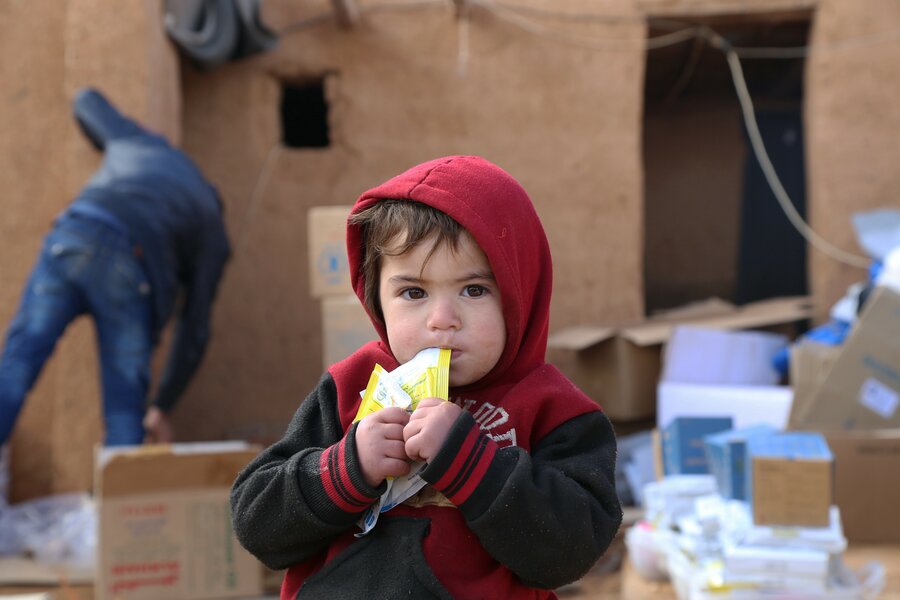
The Democratic Republic of the Congo
Africa's second largest country continues to face one of the world's largest hunger crises - a total 26 million people are acutely food insecure - driven by protracted conflict, disease and climate shocks. DRC is home to the highest number of internally displaced people in Africa at 5.7 million, while almost half-a-million refugees have arrived from neighbouring countries. WFP provides food, nutrition and cash assistance. See also: Emergency page
Sahel
The Sahel is staring down a worsening and complex food crisis as conflict, COVID-19, climate, and rising costs collide to put basic meals out of reach for millions. Over 10.5 million people are facing crisis levels of hunger, including 1.1 million on the brink of famine, across five countries - Burkina Faso, Chad, Mali, Mauritania, Niger. WFP programmes have been more than a lifeline for millions in the Sahel, helping communities grow and prosper despite the challenges they face. See also: Emergency page
Other emergencies: Central African Republic, Chad, Colombia, Haiti, Kenya, Madagascar, Mali, Mozambique, Myanmar, Niger, Philippines, Somalia, Sudan and Venezuela.
Campaigns
#StopTheWaste
#StopTheWaste is a movement for change which highlights the global issue of food waste and simple solutions we can all take to prevent it. Globally, one-third of the food produced for human consumption is lost or wasted, amounting to about 1.3 billion metric tons per year. The financial costs of food wastage amount to about US$1 trillion each year. This is clearly a challenge we must solve as we work towards achieving zero hunger by 2030.
Funding in 2021
Total contributions: US$9.6 billion (a record). Total budgetary needs: US$14.8 billion
UNHAS
WFP Aviation manages the only UN-mandated air transport service, the United Nations Humanitarian Air Service (UNHAS). The service connects the entire humanitarian and development community to people in need, reaching the most remote and dangerous locations on earth. It also ensures an uninterrupted delivery of supplies when other transport is disrupted by insecurity or damaged roads or other infrastructure, and where almost no other commercial airline is flying.
UNHAS served 400 regular destinations in 23 countries facing crises and emergencies in 2020, operating more than 100 aircraft. The service supported the global response to COVID-19, including providing a Medical Evacuation Service and transporting medical cargo and staff.






